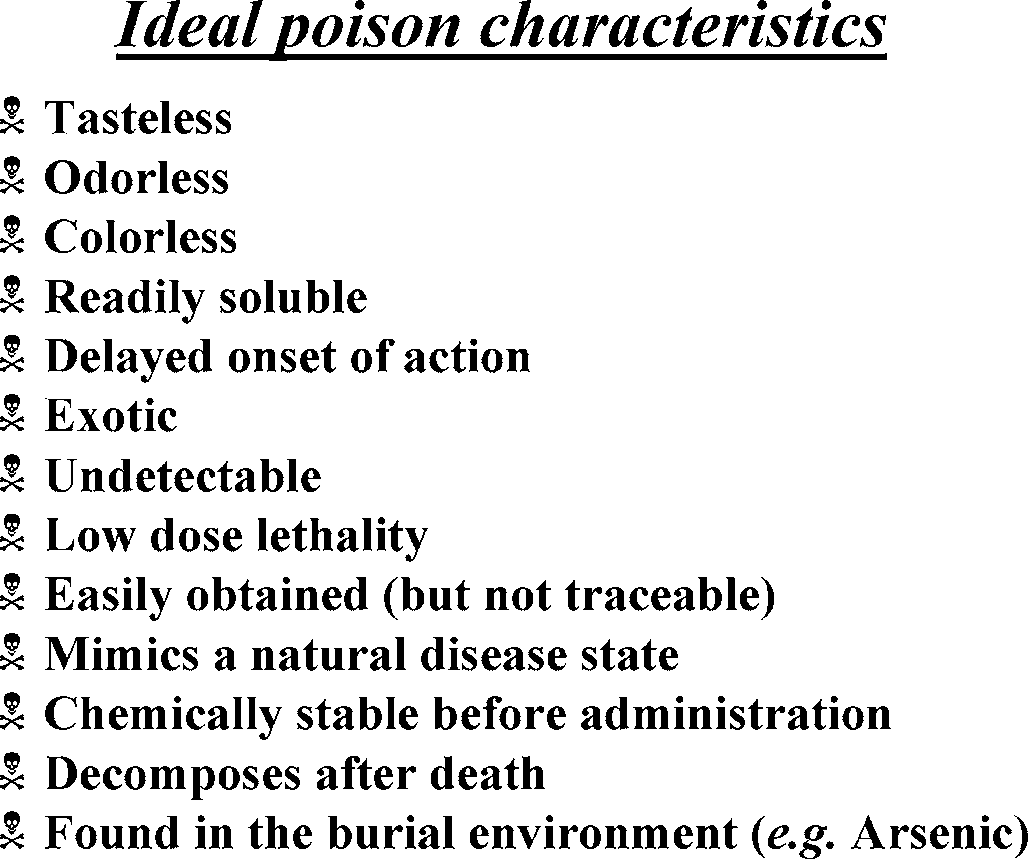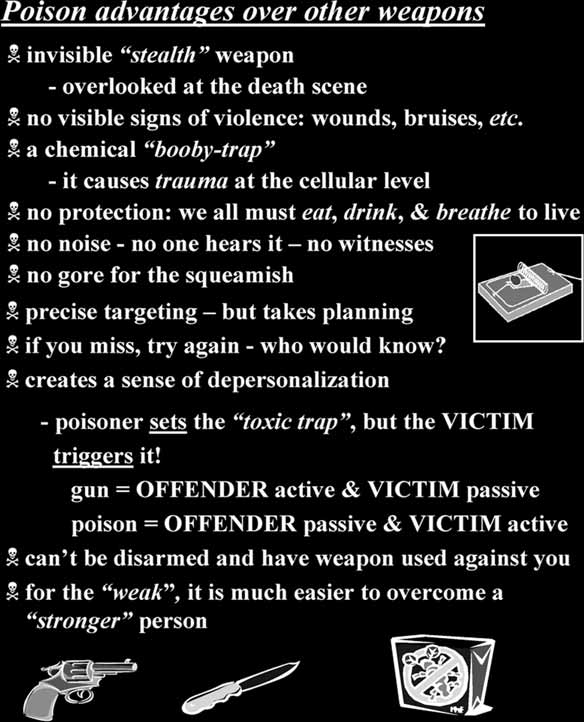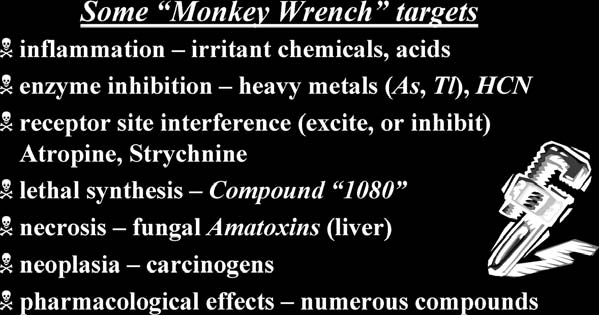Criminal Poisoning: Investigational Guide for Law Enforcement, Toxicologists, Forensic Scientists, and Attorneys (9 page)
Authors: John H. Trestrail

32
Criminal Poisoning
Figure 2-2
these characteristics as possible. What follows are some of the characteristics of such an ideal homicidal poison:
• It should be odorless, tasteless, and colorless. This allows administration to the intended victim without any warning signs that the victim can detect by the normal bodily senses of smell, taste, and sight.
• It should be readily soluble, preferably in water. This allows easy administration in normal foods and drinks of which the victim may partake.
• It should have a delayed onset of action. This allows a time period in which the poisoner can attempt to create an alibi.
• It should be undetectable, and certainly the more exotic the poison the more likely that it will not be detected in more routine toxicological analyses.
• It should have a low-dose lethality, which means less of the toxic material needs to be administered in the dose. It is much easier to administer a pinch of a substance, rather than a pound.
• It should be easily obtained, but not traceable, so that it will leave no investigative trail that would lead to the poisoner.
• It should be chemically stable. This makes it easy to store without loss of potency.
• It should decompose/break down on death.
• It should be found as a naturally occurring substance in the environment of the burial place.

Types of Poisons
33
Figure 2-3
The heavy metals (e.g., arsenic, antimony, mercury, lead) are elements or elemental compounds and are as toxic today as they were when first created millions of years ago. These compounds tend to remain detectable many years after a victim’s burial, which is advantageous for law enforcement investigators.
Probably one of the greatest aspects desired in a poison is for its effects to mimic a natural disease state, because the poisoning will be missed. A death certificate would then bear an unrelated medical cause of death, and the victim would be buried without detection of an actual crime.
See
Fig. 2-3
for a summary of the ideal characteristics of poison discussed here.
2.3. CONTRASTS BETWEEN POISONS
AND MORE TRADITIONAL WEAPONS
Certainly one of the main advantages of poison over the more traditional weapons is that it is invisible as a weapon. One might therefore consider it a “stealth” weapon. The unsuspecting victim never sees it coming and, therefore, cannot provide any form of reasonable defense to the attack.
34
Criminal Poisoning
In effect, a poison is a “chemical bomb.” It does not explode with an external violent force, but, nonetheless, like an explosive, it destroys the internal natural workings of a victim’s physiology. It could be reasonably hypothesized, therefore, that a poisoner would show some of the same characteristics one would find in the profile of a bomber. Bombers are usually Caucasian, male, underachievers, nonathletic, cowardly, neat and orderly, meticulous, loners, careful planners, and nonconfrontational (either physically or psychologically); possess average to above average intelligence; and have inadequate personality (Meloy & McEllistrem, 1998).
Usually no trauma or visible signs of a poison’s effects are found on a victim’s body, because the body kills itself physiologically via a chemical short circuit. This allows the poisoner to choose what symptoms he or she wishes the victim to exhibit, based on the chemical and toxicological nature of the poison selected. The victim has no protection as long as he or she eats, drinks, and breathes. Of course, if the poisoner could get the victim to stop these essential natural body processes, there would be no need to administer the poison. However, we must all carry out the processes of eating, drinking, and breathing, so we are all essentially vulnerable to the attack of a poisoner.
A poison is a silent weapon. There is no noise like that of a gun being fired; therefore, a poison could be considered the ultimate silencer. Unlike for a shooting, in which the shot could be heard and reported by someone, it would be impossible to find a witness who could state that he or she heard the sound of a cyanide molecule going off in the dead of night. In addition, in an attack carried out with a gun, there is always the chance that some innocent bystander could become injured or killed. However, poison allows the careful-planning poisoner to carry out very precise targeting on a victim while leaving nearby bystanders unharmed and unaware that the crime has even been attempted or perpetrated. Thus, a highly skilled poisoner could murder a single individual at a large banquet without being detected.
Certainly a poison allows the poisoner to overcome easily a physically or mentally stronger person by invading that person’s defense zone. The poisoner therefore may be physically or psychologically nonconfrontational. For example, a petite wife could easily overcome the brute strength of an abusive spouse, and a weaker-willed husband could overcome the abusive personality of a more domineering spouse.
If the first attempt to poison is unsuccessful, this type of weapon provides a chance for the poisoner to try again, because the victim is still unaware that an initial attempt at murder has even been made. In addition, unlike with more traditional weapons, the poisoner is unlikely to be disarmed of the poison and have the weapon used against him or her. Poison is also very easily Types of Poisons
35
overlooked at the death (crime) scene, because it is often appears like any natural substance that is usually found in the environment. With this type of weapon, it is quite possible to make a murder look like suicide, or a suicide look like murder. Furthermore, for the poisoner who might be squeamish at the site of blood or gore, or who is concerned about having to clean up the scene of the murder, there is no such messy component to the crime of poisoning.
With this type of murder, there is a certain degree of depersonalization: in the mind of the poisoner, he or she merely sets the trap; it is the victim who actually springs it. This rationalization allows the poisoner to lessen the guilt that he or she may feel about being the one who actively carries out the deed (
see
Fig. 2-4
).
2.4. HOW DO POISONS KILL?
Like a wrench thrown into a finely tuned engine of a car would disrupt its proper running, the chemical molecule, like a “chemical monkey wrench,”
disrupts the proper running of the body’s biochemical processes. Literally thousands of these “chemical monkey wrenches” are available to the poisoner. Each poison can be carefully selected to disrupt a specific body process.
Fig. 2-5
shows some of the major classifications of poisons based on how they will do their dirty work on various organ systems.
Poisons can kill a victim in a number of ways, depending on the effects of the chemical substance on the body’s normal physiology.
2.4.1. Central Nervous System Effects
By altering the critical function of the body’s nervous system, a poison can cause central nervous system depression, resulting in coma; loss of the respiratory drive, resulting in respiratory arrest (the stoppage of breathing); and loss of the reflexes protecting the airway, resulting in a flaccid tongue obstructing the airway, or aspiration of gastric contents into the bronchial tree. The poison can also affect the heart with cardiovascular (circulatory) effects, including hypotension (low blood pressure) from decreased cardiac contractions, hypovolemia from loss of fluids, peripheral vascular collapse, or cardiac arrhythmias.
The body’s cells can die from a lack of oxygen necessary for normal cellular respirations, called cellular hypoxia (low oxygen at the cellular level), owing to a breakdown in the normal transport of oxygen. There can be seizures resulting from muscle hyperactivity, which results in hyperpyrexia (increase in body temperature); or kidney failure, resulting from destruction of muscle tissue (deposition of myoglobin in the kidneys). There can be brain
36
Criminal Poisoning
Figure 2-4
damage from lack of oxygen, which results in loss of the master control for the entire body engine. Death can be caused by pulmonary aspiration, which results in chemically induced pneumonia and destruction of the lungs.
Some poisons seem to pinpoint specifically a particular vital organ of the body. For example, the herbicide Paraquat destroys the lungs, the analgesic acetaminophen or the fungal amatoxins destroy the liver, and antifreeze (ethylene glycol) or another fungal toxin called orellanine destroys the kidneys.
For some of the more common homicidal poisons, the investigating officer and analytical toxicologist can find poison profiles in the appendix to this
Types of Poisons
37
Figure 2-5
volume. In each profile, the investigator will find discussions of the following important points about the poison: • Form
• Common color
• Characteristic odors
• Solubility
• Taste
• Common sources
• Lethal dose
• Mechanism
• Possible methods of administration
• Time interval of onset of symptoms
• Symptoms resulting from acute exposure
• Symptoms resulting from chronic exposure
• Disease states mimicked by poisoning
• Notes relating to the victim
• Specimens from the victim to be obtained for analysis
• Analytical detection methods
• Known toxic levels
• Notes pertinent to analysis of the poison
• List of selected homicide cases in which particular poisons were used What quantity of a poison would be necessary to produce a lethal outcome in a human victim? Many individuals are surprised to learn that a minute amount of a poison can result in death. To give the reader a hands-on feel for lethal amounts, let us use as a reference the weight of one US nickel (or two
38
Criminal Poisoning
Figure 2-6
pennies). The average weight of these American coins is approx 5000 mg. If one had the same weight of some common homicidal poison, how many human lethal doses would this weight equal?
See
Fig. 2-6
for examples of poisons and the number of lethal doses contained in this weight.
